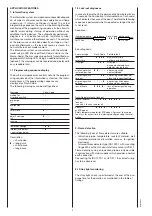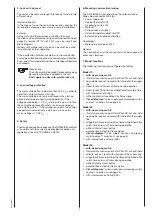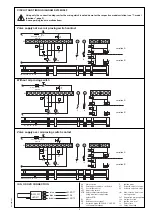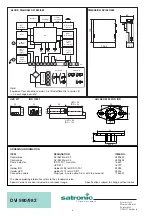
2
DVI 980/982
APPLICATION FEATURES
1. Information system
The information system is microprocessor based and reports
on all aspects of burner control box operation and flame
supervision. It informs continuously about the actual
programming sequence the unit is just performing. Besides
monitoring of the programming sequence it also allows to
identify errors during start-up of operation without any
additional testing devices. The automatically performed
diagnosis is a valuable tool which facilitates service/
maintenance work and therefore saves costs. The analyses
of the error cause can be done directly on stage or if not
possible afterwards as the lock out reason is stored in a
non-volatile lock out mode memory.
The information system communicates with the outside
world using a LED (the used Flash-Code is similar to the
Morse-Code). The messages are optically transmitted by a
appropriately flashing LED. Using an additional terminal
(optional), the messages can be recorded and displayed in
easy readable form.
1.1 Programming sequence display
The built-in microprocessor controls not only the program-
ming sequence but the information system too. The indivi-
dual phases of the programming sequence are
displayed as Flash-Code.
The following messages can be distinguished:
Message
Flash-Code
waiting for
❘ ❘
.
air proving switch
pre-purge
❘ ❘ ❘
.
tv1
pre-ignition
❘ ❘ ❘ ❘
.
tvz
safety time
❚ ❘
.
ts
delay 2nd stage
❚ ❘ ❘
.
tv2
running
❘
_
low mains voltage
❘ ❚ ❚
_
Internal fuse defect
❘ ❚
_
> control box defect
Description
❘
= short pulse
❚
= long pulse
. = short pause
_ = long pause
1.2 Lock-out diagnoses
In case of a failure the LED is permanently illuminated. Every
10 seconds the illumination is interrupted by a flash code,
which indicates the cause of the error. Therefore the following
sequence is performed which is repeated as long as the unit
is not reset.
Sequence:
illuminated phase
dark phase
Flash-Code dark phase
❘ ❚ ❚ ❚ ❚
for 10 sec
for 0.6 sec
for 1.2 sec
Error diagnosis:
Error message
Flash-Code
Possible fault
lock out
❘ ❚ ❚ ❚ ❚
within safety time
safety time
no flame establishment
stray light
❘ ❘ ❚ ❚ ❚
stray light
during monitored phase,
detector may be faulty
air proving switch
❚ ❚ ❘ ❘ ❘
air proving switch
in closed position
contact welded
air proving switch
❘ ❘ ❘ ❚ ❚
air proving switch does not
time-out
close within specified time
air proving switch
❘ ❘ ❘ ❘ ❚
air proving switch opens
opened
during start or operation
loss of flame
❚ ❚ ❚ ❚ ❘
loss of flame signal during
operation
Flash-Code for manual lock out
manual/external
❘ ❘ ❚ ❚ ❚
❚ ❚ ❚ ❚ ❚
lock out
(see also 3. lock out and reset)
Error RV1
❚ ❚ ❚ ❚ ❘ ❘ ❚ ❚ ❚ ❚
or STB opens
Safety temperature delimiter STB opens. For reset, the supply
line must, for a short time, be interrupted after pushing the reset
button.
2. Flame detection
The following types of flame detectors are suitable:
– Ionisation probe, temperature resistant material, well
insulated (material and insulation same as for ignition
electrode).
– Infrared-flicker detector type IRD 1020.1 with mounting
flange M 93 or the UV solid state flame sensor UVD 971.
Flame detection using an ionisation probe is only possible
in conjunction with mains supplies which provides a neutral
earth connection.
Connecting the IRD 1020.1 or UVD 971 the correct wiring
has to be observed.
2.1 Stray light monitoring
The stray light check is performed at the end of the pre-
purge time for the duration as mentioned in the table of
timings.
























